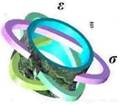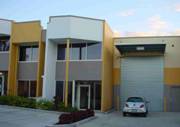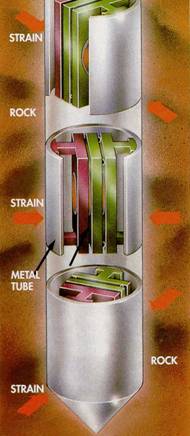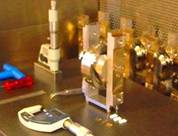|
GTSM Technologies |


|
Home |
|
GTSM History |
|
Tensor Strain in California for NEHRP |
|
Tensor Strain in Taiwan |
|
Tensor Strain for PBO / Unavco |
|
Tensor Strain in Japan |
|
Mining Applications |
|
Stability Research |
|
Frequently Asked Questions |
|
Advanced Frequently Asked Questions |
|
Publications |
|
Contacts |
|
Frequently Asked Questions
|
|
What is a Strainmeter? Strain meters measure change of dimensions in a body. The result is expressed as a change of dimension per unit dimension. As an example if the distance between two points which are 1 km apart (1000,000 mm) changes by 1 mm, the strain is said to be 1 microstrain or 10 –6 , or 1 me . In the earth strains as large as a few microstrain are common in earthquake areas, and strains of 50 nanostrain ((50 ne or 50 x 10 –9 ) occur daily due to the gravitational attraction of the moon and the sun. Geophysical strainmeters measure these changes of dimension in near surface rock. This can be done by direct measurement of changing distance between well spaced points on the earth by for example GPS measurements or laser strain meters. Other strain meters measure the change of dimensions of a borehole. This can be done by direct measurement of the borehole diameter or by the change of volume imposed on an instrument embedded in the borehole. There are two types of strain measured in a near surface vertical borehole. The first is called an areal strain in which the deformation is the same at all azimuths (a circular borehole remains circular). Some strain meters (eg Sacks Evertson Volumentric strain meters) measure only this type of strain. There is another kind of strain called a shear strain in which deformation of the borehole is different in different directions. With shear strain, a circular borehole becomes elliptical. Shear strains are very common in major fault systems like the San Andreas system. It is common for both areal strain and shear strains to be present simultaneously in the earth.
What is a GTSM Strainmeter? A GTSM strainmeter measures the change of diameter of a borehole in at least three directions usually at 120 degrees from each other. The instrument is grouted into the borehole using an expansive grout to ensure it is always under compression. Areal strains are characterized by observations which are equal on all gauges. Shear strains are identified by examining the differences between gauge responses. There can be two kinds of shear strain. The GTSM strain meter measures all three kinds of strain in the plane perpendicular to the borehole, and this requires a minimum of three gauges. In practice, GTSM strain meters have a fourth gauge included in case one of the primary gauges fail.
Why use different kinds of strain meter? For large scale long term motions of the earth such as is used to map the large scale motions of the earth in major fault zones, GPS based strain measurement is ideal. The limitation of these measurements are that short term deformations cannot be adequately measured because of the noise in the data due to atmospheric effects and near surface ground noise. GPS is best for mapping long term phenomena. For higher sensitivity studies critical for observation of the short term (minutes to months) strain changes which are very common, borehole strain meters which operate at several hundred times higher sensitivity are necessary. The GTSM system was developed to study these phenomena.
How deep are the Holes? Generally, the holes are between 150m and 250m, however the current instruments may be placed anywhere up to 1000m. In this case preparation of the hole becomes much more expensive. Hole drilling and preparation is the major cost element in the deployment of borehole strain meters.
How sensitive are the gauges? A single unit of measurement for our gauges represents 4pm of diameter change. This is 4 x 10 12 m, or 1/25 the radius of a hydrogen atom, or one ten millionth of the width of a human hair. This represents a strain of about 0.05 nano strain. The ground noise present in a borehole limits the useful sensitivity range, and depends on the time duration of the phenomena under study. Short term signals (such as seismic waves) are measured to about 0.1 nanostrain. Daily changes in earth strain are normal at about 1 nanostrain, and these normal changes further limit useful sensitivity measured to about 1 nanostrain (1 ne ).
How do they work? In a simple DC circuit with two resistors, the voltage at the center point of the two resistors, is directly related to the ratio between the values of the two resistors. The same general principle applies with capacitors in an AC circuit. Our system uses three steel plates acting as capacitors. Two of the plates (green) are a fixed distance apart mounted on one end of the sensing diameter, and the third (red) mounted on the other end of the same diameter moves as the diameter of the borehole changes. We measure the change in capacitance as the single plate moves, and from that find the ratio of the separation between each plate pair.
What is the difference between a GTSM Strain Meter and a Seismometer? The GTSM Strain meters are continuously measuring the changes in borehole shape (deformation) regardless of the rate of change. Seismometers typically have a weight suspended on a spring. When a seismic wave moves through the instrument, the weight moves relative to the instrument and the output signal is proportional to the velocity of the particles in the rock. For this reason, seismometers are excellent at recording high frequency earthquake data. Strain meters can also measure these waves, but do so by directly measuring the change of position of the borehole wall. This deformation can be very slow for many earth signals, such as the strain on the earth resulting from lunar and solar tides or from slow earthquakes. This is where the GTSM strain meter has a definite advantage.
How do we get one? You can contact GTSM Technologies by sending us an Email. The systems take more than 10 months to build from order to delivery, and this time includes a detailed 3 month testing process to ensure reliability. The design lifetime is greater than 20 years.
|


